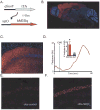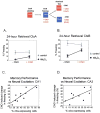Generation of a synthetic memory trace
- PMID: 22442487
- PMCID: PMC3956300
- DOI: 10.1126/science.1214985
Generation of a synthetic memory trace
Abstract
We investigated the effect of activating a competing, artificially generated, neural representation on encoding of contextual fear memory in mice. We used a c-fos-based transgenic approach to introduce the hM(3)D(q) DREADD receptor (designer receptor exclusively activated by designer drug) into neurons naturally activated by sensory experience. Neural activity could then be specifically and inducibly increased in the hM(3)D(q)-expressing neurons by an exogenous ligand. When an ensemble of neurons for one context (ctxA) was artificially activated during conditioning in a distinct second context (ctxB), mice formed a hybrid memory representation. Reactivation of the artificially stimulated network within the conditioning context was required for retrieval of the memory, and the memory was specific for the spatial pattern of neurons artificially activated during learning. Similar stimulation impaired recall when not part of the initial conditioning.
Figures




Comment in
-
Neuroscience. The imaginary mind of a mouse.Science. 2012 Mar 23;335(6075):1455-6. doi: 10.1126/science.1220824. Science. 2012. PMID: 22442473 No abstract available.
-
Artificial activation of a memory trace.Nat Rev Neurosci. 2012 Apr 13;13(5):287. doi: 10.1038/nrn3242. Nat Rev Neurosci. 2012. PMID: 22498898 No abstract available.
-
A technology for memory.Nat Methods. 2012 May;9(5):431. doi: 10.1038/nmeth.2003. Nat Methods. 2012. PMID: 22803198 No abstract available.
References
-
- Doty RW. Annu Rev Psychol. 1969;20:289. - PubMed
-
- Shinkman PG, Swain RA, Thompson RF. Behav Neurosci. 1996 Oct;110:914. - PubMed
-
- Romo R, Hernandez A, Zainos A, Salinas E. Nature. 1998;392:387. - PubMed
-
- Jasper H, Penfield W. Epilepsy and the Functional Anatomy of the Human Brain. 2. Little, Brown and Co.; 1954.
Publication types
MeSH terms
Substances
Grants and funding
LinkOut - more resources
Full Text Sources
Other Literature Sources
Medical
Molecular Biology Databases

